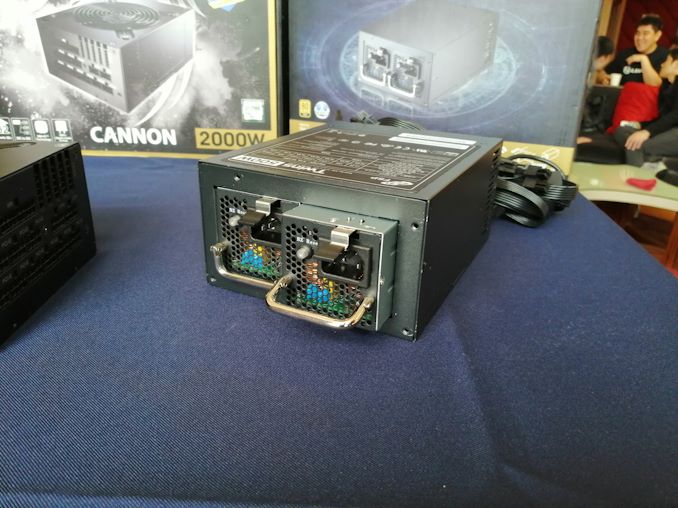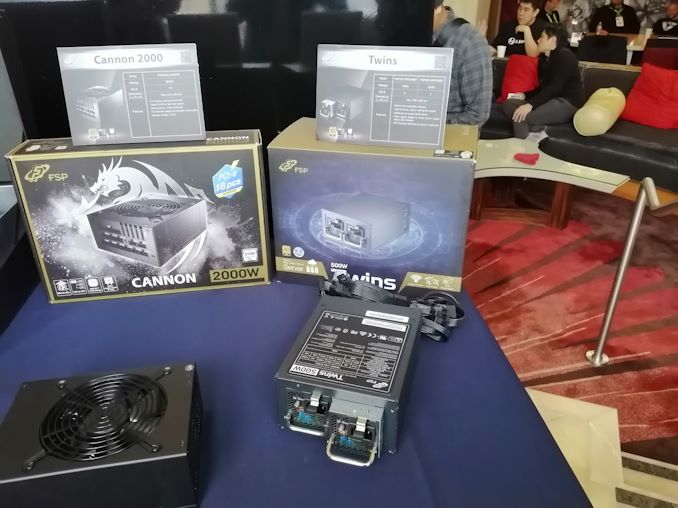FSP Twin Redundant PSU: 900W Due Later This Year
by Ian Cutress on January 8, 2019 8:30 AM EST- Posted in
- PSUs
- FSP
- Trade Shows
- FSP Twins
- CES 2019

The consumer market is not used to the idea of redundant power supplies. For the enterprise market, redundant PSUs give peace of mind by eliminating a single point of potential failure. It can also protect the components should one power supply have a mishap, as the other supply can take over. The power supplies can be hot plugged as well, keeping the system alive in case one power supply needs to be replaced. For desktop/workstation users who want this level of security, there have not been many options to choose from except to purchase from the enterprise market. Last year, FSP introduced its 'Twin' range of redundant power supplies for consumers.
Over 2018, the company introduced two units, a 700W and a 500W model. The hardware fits into a standard ATX power supply bay, and the only difference in setups will be that two power cords are needed. The pickup of these units in certain markets has been so good, the company is working on a 900W model to address the higher-end of the target market. We were told that work on this unit is ongoing, and likely to be shown at the end of the year. FSP makes its own power supplies as an ODM, so they want to also hit the efficiency points as well. I was told that I'll likely see it either at Computex later this year or next year at CES.











17 Comments
View All Comments
brettjp - Wednesday, January 9, 2019 - link
To the op and all the responses.The purpose of a product like this is not to solve all issues, and is not targeted to all consumers. The purpose is to avoid a system from shutting off due to a failed PSU, nothing else. The hot swappable PSU benefit is a feature in place designed to restore the redundancy offered by the main purpose.
For remedying other potential power issues, use should include each PSU being plugged into independent power sources, with a healthy UPS in between. Regular monitoring of the PSUs and UPSs is good practice, of course. None of that is required to use it, but are how you would make best use of it.
Use case scenarios would obviously vary. Mainly I see three things, though I'm sure there are others. Something on your PC is a source of income, and for it to function, it must remain on. You have some sort of data or service on your PC that must always remain accessible, but you don't want to host it on a cloud service. Or you're an enthusiast about technology and this interests you.
This isn't here to fix a failed motherboard or other unrelated potential issue. It's not a fix-all solution. Just one solution for one problem.
Just because it may not seem practical to you does not mean it won't have its uses or people's interest. I agree, this seems a fairly niche product. I don't have a use for it at this time. But I definitely like that it exists as a consumer option, and may want it eventually.
Manch - Thursday, January 10, 2019 - link
I understand what it does. I run mirrored servers for my data 24/7, separate power, UPS. If one server goes down for ANY reason, the other will continue on. This is also very niche, and I know this.In my experience, if you do not take any of the other mitigations into account. You plug this into the same power. When/if the PSU does go out, you'll probably trip the breaker, burn the powerstrip/socket, etc and will lose power regardless. Looking at the causes for failure, the PSU being defective from an internal failure as the culprit is usually the least of your worries. most PSU failures come from mainly from lack of PME, brown outs, ie external reasons. They can be mitigated greatly with an UPS.
If you are in need of 24/7 always on/non cloud storage/processing, etc you're probably already looking at enterprise grade equipment to begin with which then makes me ask the question. Who is this for?
namechamps - Tuesday, January 8, 2019 - link
The size of each of the redundant modules shows we really need a new case/power supply/ motherboard connector standard. ATX is ancient and bloated.DanNeely - Tuesday, January 8, 2019 - link
SFX power supplies are already half the volume of a nominal standard length ATX unit (0.8 liters vs 1.8). Like with redundant modules you pay a significant price premium for the reduced size. You also pay in more noise due to the smaller fans; SFX with an 80mm fan is still going to be better than the 60mm fan that's all there will be room for in the modular unit (assuming each module has its own fans for redundancy anyway).The real point where ATX could go on a diet is the 24 pin connector. Unlike in the mid 90's modern boards use very little 3.3/5V power and most don't use -12V at all (basically just for RS-232 serial ports); you could drop about half the wires from the 24 pin (since you could also cut the number of ground wires back) without hurting anything needed in a modern PC. The problem is that as an innovation target the desktop PC is dead, which means that even just making half the wires optional for a more flexable wire bundle without defining a new smaller connector is never going to happen.
taw6 - Tuesday, January 8, 2019 - link
What a useless product, the point of a redundant power supply is to be fed from different power sources, who has that at home and if you do you can very easily afford a low end commercial server and support contract.zodiacfml - Wednesday, January 9, 2019 - link
I guess small businesses without server class hardware?However, office files can be made redundant with the cloud or using Google for Business.
Here is I think a good one, storage. CCTV recorders made from off the shelf hardware. Small video rendering farms.